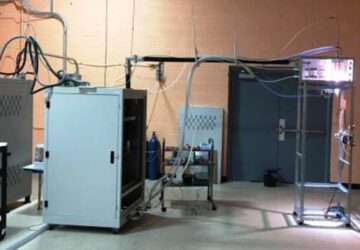Curious about the advantages of incorporating reliability services into industrial operations? These essential services bring a multitude of benefits that can revolutionize your business processes. Picture this: significantly reduced downtime, leading to uninterrupted production and increased efficiency. Imagine extending the lifespan of your equipment, translating to long-term savings and improved ROI. Furthermore, reliability services contribute to enhancing safety measures, safeguarding both personnel and assets. By pinpointing potential issues before they escalate, these services prevent costly breakdowns and enable proactive maintenance. The result? A seamless workflow, elevated productivity, and a competitive edge in the market. Embrace reliability services today and unlock a world of advantages for your industrial operations
Enhanced Asset Management through Reliability Services
Asset management is crucial for smooth industrial operations. Effective asset management ensures maximum return on assets and optimal utilization of resources. Reliability services aid in effective asset management in several ways.
1. Predictive and Preventive Maintenance Strategies:
Reliability engineers collaborate with plant teams to establish tailored predictive and preventive maintenance routines for each equipment type and criticality level. This is based on techniques such as:
- Failure Modes and Effects Analysis (FMEA) to identify potential failure modes.
- Reliability-Centered Maintenance (RCM) to customize maintenance activities to mitigate failures.
- Mean Time Between Failures (MTBF) analysis to determine optimal maintenance frequencies.
- Root Cause Failure Analysis (RCFA) to eliminate the recurrence of failures.
These strategies aim to prevent premature failures, avert unplanned downtime, extend equipment life, and decrease maintenance costs
2. Real-Time Asset Health Monitoring
Reliability services design and implement sensor systems and data infrastructure to enable real-time asset health monitoring. This includes:
- Vibration, temperature, pressure, and other sensors to track equipment condition.
- Data acquisition systems to collect sensor data.
- Communication protocols like Wi-Fi, Bluetooth, and cellular to transmit data.
- Data storage systems like data historians and cloud databases.
Advanced pattern recognition analytics are applied to detect anomalies and identify problems early. This allows taking preventive action before asset failure.
3. Inventory and Procurement Optimization
Reliability data and analytics enable optimizing spare parts inventory and procurement strategies:
- Criticality analysis ensures stocking adequate spares for vital assets.
- Demand forecasting, and inventory modeling help determine min/max levels.
- Contracts are established with vendors for critical spare supplies.
This ensures parts availability without excess inventory carrying costs.
4. Enhanced Overall Equipment Effectiveness
By reducing equipment failures, unplanned downtime, and maintenance duration, reliability services improve Overall Equipment Effectiveness (OEE), a key metric for asset utilization.
For instance, a fertilizer manufacturer boosted OEE from 81% to 90% using reliability services from Rockwell Automation. This enhanced production capacity by over 10% without capital expenditure.
By employing these approaches, asset managers who leverage reliability services can enhance operational performance by up to 30%. Let’s now explore the role of reliability services in asset condition monitoring.
Having examined how reliability services enhance asset management, let’s delve into their role in improving asset condition monitoring
Improved Asset Condition Monitoring
Asset condition monitoring provides real-time insights into equipment health. This allows for predicting failures, preventing downtime, and planning maintenance. Reliability services are indispensable for state-of-the-art condition monitoring.
Reliability engineers select appropriate sensors and data acquisition systems for each asset type. Vibration sensors help detect misalignments and loose parts in rotating machinery. Acoustic sensors identify leaks and blockages. Temperature and pressure sensors monitor components operating under extreme conditions.
Reliability services also implement advanced analytics platforms to translate raw sensor data into actionable intelligence. Predictive algorithms identify trends and anomalies to detect emerging failures. Digital twins enable what-if analysis to evaluate maintenance strategies.
With these technologies, reliability services transform raw data into timely insights for predictive maintenance. For example, airplane engine manufacturers like GE Aviation use sensors and analytics to monitor engine vibration, temperature, and other parameters during flight. This has reduced flight cancellations due to engine issues by 65%.
Having understood how reliability services enhance asset condition monitoring, let’s examine how they optimize work execution management.
Optimized Work Execution Management
Executing maintenance work productively is key to efficient operations. Reliability services optimize work execution management in four key ways:
- Planning and Scheduling: Reliability engineers sequence and schedule preventive maintenance for minimal disruption and maximal utilization.
- Standardization: Reliability programs develop standard operating procedures for each task for consistency.
- Resource Optimization: Crews, tools, parts, and bays are optimally allocated to maintenance jobs.
- Performance Metrics: Key performance indicators like the mean time between failures, overall equipment effectiveness, etc. are tracked to improve maintenance. However, with industrial components, you can execute effective maintenance, fostering key operational measures.
For instance, a metal fabrication plant achieved a 23% increase in production uptime by implementing work order planning, scheduling, and monitoring with the help of reliability services experts.
Now that we’ve seen how to work execution is optimized, let’s examine the strategic role of reliability services in maintenance management.
Strategic Maintenance Management
Reliability services provide long-term strategies aligned with business objectives like safety, sustainability, and product quality. For example:
- Reliability-Centered Maintenance (RCM): Criticality analysis is conducted to identify failure modes and customize maintenance for optimal results.
- Risk-Based Maintenance: Asset downtime and safety risks are evaluated to determine maintenance priorities and frequencies.
- Total Productive Maintenance (TPM): Operators are trained to conduct basic maintenance to develop ownership.
- Sustainability: Asset maintenance is aligned with sustainability targets by extending equipment lifespan, reducing material consumption, recycling, etc.
Leading automotive companies achieve a 30-40% reduction in maintenance costs by moving from conventional time-based maintenance to strategic, risk-based techniques centered on reliability.
This Pie chart will help you with a better understanding of depicting maintenance cost distribution:
Source: 2022 Maintenance Benchmarking Report by ARC Advisory Group
Having explored the key benefits of reliability services in industrial operations, let’s look ahead at what the future holds.
The Future of Reliability Services
Several technology trends will shape reliability services in the future:
- Industrial IoT: Smart sensors will provide richer data for advanced analytics and machine learning predictions.
- Digital Twin Modeling: Assets’ digital clones will enable testing maintenance strategies through simulation.
- AR/VR: Immersive technologies will assist technicians to improve productivity and accuracy.
- Robotics and Automation: Robots will take on dirty, dangerous, and repetitive maintenance tasks.
- Additive Manufacturing: 3D-printed spare parts will enable on-demand part fabrication.
According to Gartner, such technologies can improve asset availability by 10% and reduce maintenance costs by 15-25% over the next 5 years.
Frequently Asked Questions
- What are the challenges in implementing reliability services?
Some key challenges are a lack of internal skills, cultural resistance, fragmented data, cybersecurity risks, and difficulty demonstrating ROI. A phased approach, change management, training programs, data integration, and pilot projects can help overcome these.
- How can SMEs benefit from reliability services?
Outsourced reliability consulting is a cost-effective option for SMEs to gain this expertise without major hires. Reliability consultants can optimize existing assets and maintenance practices using proven strategies.
- What is the role of technology like AI and IoT?
These technologies allow low-cost sensing, massive data capture, and data analytics at scale. This enables asset optimization and maintenance improvements not possible previously.
In Conclusion
In summary, reliability services deliver multidimensional benefits spanning enhanced asset management, improved monitoring, optimized work practices, and strategic maintenance. With technologies like IIoT, automation, and 3D printing advancing reliability capabilities, the future looks brighter than ever for industrial operations. Partnering with reliability experts will be key to leveraging these advances.








